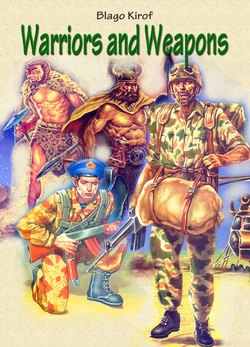Читать книгу Warriors and Weapons - Blago Kirof - Страница 7
На сайте Литреса книга снята с продажи.
Ancient Greeks
ОглавлениеThe fractious nature of Ancient Greek society seems to have made continuous conflict on this larger scale inevitable. Connected with the rise of the city-state was the evolution of a new way of warfare - the hoplite phalanx. When exactly the phalanx developed is uncertain, butis thought to have been developed by the Spartans. The chigi vase, dated to around 650 BC, is the earliest depiction of a hoplite in full battle array. The hoplite was a well-armed and armored citizen-soldier primarily drawn from the middle classes. Fighting in the tight phalanx formation maximised the effectiveness of his armour, large shield and long spear, presenting a wall of armor and spearpoints to the enemy.
With this evolution in warfare battles seem to have consisted mostly of the clash of hoplite phalanxes from the city-states in conflict. Since the soldiers were citizens with other occupations, warfare was limited in distance, season and scale. Neither side could afford heavy casualties nor do sustained campaigns, so conflicts seem to have been resolved by a single battle.
The scale and scope of warfare in Ancient Greece changed dramatically as a result of the Greco-Persian Wars. To fight the enormous armies of the Achaemenid Empire was effectively beyond the capabilities of a single city-state. The eventual triumph of the Greeks was achieved by alliances of many city-states (the exact composition changing over time), allowing the pooling of resources and division of labour.
The historian Diodorus Siculus (1st century BC), described the invention of a mechanical arrow-firing catapult (katapeltikon) by a Greek task force in 399 BC. The weapon was soon after employed against Motya (397 BC), a key Carthaginian stronghold in Sicily.
The other Greek author, Biton (2nd c. BC), described two advanced forms of the gastraphetes, which he credits to Zopyros, an engineer from southern Italy. Zopyrus has been plausibly equated with a Pythagorean of that name who seems to have flourished in the late 5th century BC. He probably designed his bow-machines on the occasion of the sieges of Cumae and Milet between 421 BC and 401 BC. The bows of these machines already featured a winched pull back system and could apparently throw two missiles at once.
From the mid-fourth century BC onwards, evidence of the Greek use of arrow-shooting machines becomes more dense and varied: Arrow firing machines (katapaltai) are briefly mentioned by Aeneas Tacticus in his treatise on siegecraft written around 350 BC. An extant inscription from the Athenian arsenal, dated between 338 and 326 BC, lists a number of stored catapults with shooting bolts of varying size and springs of sinews.
Arrow firing machines in action are reported from Philip II's siege of Perinth (Thrace) in 340 BC. At the same time, Greek fortifications began to feature high towers with shuttered windows in the top, which could have been used to house anti-personnel arrow shooters, as in Aigosthena. Projectiles included both arrows and later stones that were sometimes lit on fire. Onomarchus of Phocis first used catapults on the battlefield against Philip II of Macedon. Philip's son, Alexander the Great, was the next commander in recorded history to make such use of catapults on the battlefield as well as to use them during sieges.
The hoplite was a small infantryman, the central element of warfare in Ancient Greece. The word hoplite (Greek hoplitēs) derives from hoplon (plural hopla) meaning an item of armor or equipment, thus 'hoplite' may approximate to 'armored man'. Hoplites were the citizen-soldiers of the Ancient Greek City-states. They were primarily armed as spear-men and fought in a phalanx.
The Hoplite Phalanx of the Archaic and Classical periods in Greece (approx. 750–350 BC) was a formation in which the Hoplites would line up in ranks in close order. The Hoplites would lock their shields together, and the first few ranks of soldiers would project their spears out over the first rank of shields. The Phalanx therefore presented a shield wall and a mass of spear points to the enemy, making frontal assaults much more difficult. It also allowed a higher proportion of the soldiers to be actively engaged in combat at a given time rather than just those in the front rank.
When advancing towards an enemy, the phalanx would break into a run that was sufficient enough to create momentum but not too much as to lose cohesion. The opposing sides would collide viciously, possibly terrifying many of the hoplites of the front row. The battle would then rely on the valour of the men in the front line; whilst those in the rear maintained forward pressure on the front ranks with their shields. When in combat, the whole formation would consistently press forward trying to break the enemy formation; thus when two phalanx formations engaged, the struggle essentially became a pushing match, in which, as a rule, the deeper phalanx would almost always win, with few recorded exceptions.
